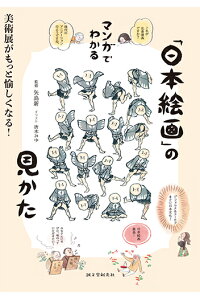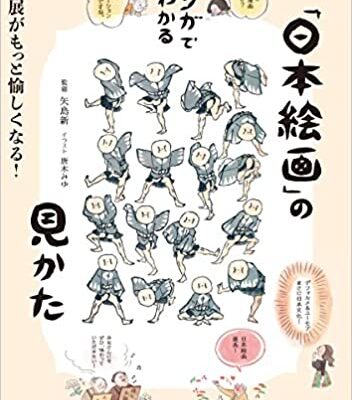矢島新 監修 「マンガでわかる『日本絵画』の見かた」 誠文堂新光社
誠文堂新光社のマンガでわかるシリーズの1つ、日本絵画の見かたを扱った本です。マンガといっても、コマ割りされたマンガではなく、文字での説明にイラスト的にマンガが描かれています。取り上げる絵画の写真もきちんと掲載されていますので、テーマごとに日本絵画を時代順に学んでいくには、もってこいの本です。
第一章は「祈りの絵」です。飛鳥時代や奈良時代の法隆寺の金堂壁画から始まり、平安時代の平家納経、室町時代の富士曼荼羅図などに続きます。荘厳さから優美さへ移っていく日本的な宗教絵画を紹介しています。
第二章は「ストーリーを描く」です。平安時代の源氏物語絵巻や、マンガの原点と言われる鳥獣人物戯画など、物語と高い親和性を見せる日本絵画の代表的な絵巻物などを紹介しています。
第三章は「モノクロの絵 vs. 華麗な絵」です。雪舟の秋冬山水図や天橋立図のような水墨画に対して、色彩豊かな上杉本の洛中洛外図屏風や狩野永徳の唐獅子図屏風を順に説明しています。紹介しているやまと絵の中に、日月山水図屏風がありました。新西国霊場三十三所の金剛寺を訪問した時に、運よく公開中で鑑賞することができた屏風です。こうやって解説を読みながら見てみると、絵に込められた意味がわかってきます。
第四章は「洗練された大胆さ」です。俵屋宗達の「風神雷神図屏風」を紹介しています。建仁寺でレプリカをじっくり見たことを思い出しました。皆さんの風神と雷神のイメージも、この屏風の絵の風神と雷神に影響されていませんか。この章では、尾形光琳の燕子花図屏風も出てきます。省略の美として良く紹介される図で、私も良く、海外からの研修生にこの絵を説明しています。
第五章は「個性的な絵」、第六章は「庶民が購入した絵」、第七章は「リアリズムに挑んだ絵」、第八章は「日本らしさを目指した絵」、第九章は「自己表現に徹した絵」と続きます。一通り読んでみても、内容をすぐ忘れてしまうので、紹介されている絵を実際に見た後に復習すると、その絵の説明を含めて頭の中に残ると思います。(完)

マンガでわかる「日本絵画」の見かた 美術展がもっと愉しくなる! [ 矢島 新 ]
価格:1,760円
(2021/6/26 17:15時点)
感想(0件)
”How to See ‘Japanese Paintings’ through Manga” supervised by Arata Yajima, published by Seibundo Shinkosha
One of Seibundo Shinkosha’s ”Manga de Wakarazu series”, this book deals with how to look at Japanese paintings. Manga does not mean a manga with panels divided into frames, but rather a manga illustrated with textual explanations. The book also includes photographs of the paintings discussed, making it an ideal book for learning about Japanese paintings by theme in chronological order.
The first chapter is “Prayer Paintings.” It begins with the wall paintings of the Golden Hall of Horyuji Temple from the Asuka and Nara periods, and continues with the Heike Nokyo Sutra from the Heian period and the Fuji Mandala from the Muromachi period. It introduces Japanese-style religious paintings that move from solemnity to elegance.
The second chapter is “Drawing Stories.” It introduces representative picture scrolls of Japanese paintings that show a high affinity with stories, such as Tale of Genji picture scrolls from the Heian period (794-1185) and caricatures of birds, animals, and people, which are said to be the origin of manga.
Chapter 3 is “Black and White Painting vs. Brilliant Painting.” It explains in turn the colorful Rakuchu-Rakugai-zu Byobu by Uesugi Hon and the Karazishi-zu Byobu by Kano Eitoku, as opposed to ink paintings such as Sesshu’s Autumn-Winter Landscape and Amanohashidate. Among the Yamato-e paintings introduced was the Nichigetsu Sansui-zu Byobu. When I visited Kongoji Temple, one of the 33 sacred places in the New West Province, I was lucky enough to see this folding screen while it was open to the public. When you look at it while reading the explanations, you can understand the meaning behind the painting.
Chapter 4 is “Sophisticated Boldness.” It introduces “The Wind and Thunder Gods” by Sotatsu Tawaraya. I remembered seeing a replica of the screen at Kenninji temple. I wonder if your image of the Wind God and Thunder God is also influenced by the Wind God and Thunder God in the painting of this folding screen. In this chapter, Korin Ogata’s Kakitsubatazu Byobu by Korin Ogata is also introduced. This painting is often introduced as the beauty of omission, and I often explain this painting to trainees from overseas.
Chapter 5 is “Individualistic Paintings,” Chapter 6 is “Paintings Purchased by the Common People,” Chapter 7 is “Paintings Challenging Realism,” Chapter 8 is “Paintings Aimed at Japaneseness,” and Chapter 9 is “Paintings Devoted to Self-Expression.” Even if you read through the book, you will quickly forget the contents, so if you review the book after actually seeing the paintings introduced in the book, you will be able to keep them in your mind, including the descriptions of the paintings. (End)
“Comment voir les peintures japonaises à travers les mangas” supervisé par Arata Yajima, publié par Seibundo Shinkosha.
Ce livre, qui fait partie de la “série Manga de Wakarazu” de Seibundo Shinkosha, traite de la manière de regarder les peintures japonaises. Il ne s’agit pas d’un manga avec des panneaux divisés en cadres, mais plutôt d’un manga illustré avec des explications textuelles. L’ouvrage comprend également des photographies des peintures abordées, ce qui en fait un livre idéal pour s’initier à la peinture japonaise par thème et par ordre chronologique.
Le premier chapitre est intitulé “Peintures de prières”. Il commence par les peintures murales de la salle dorée du temple Horyuji des périodes Asuka et Nara, et se poursuit avec le Heike Nokyo Sutra de la période Heian et le Fuji Mandala de la période Muromachi. Il présente des peintures religieuses de style japonais qui passent de la solennité à l’élégance.
Le deuxième chapitre est intitulé “Dessiner des histoires”. Il présente des rouleaux d’images représentatifs des peintures japonaises qui présentent une grande affinité avec les histoires, comme les rouleaux d’images du Conte de Genji de la période Heian (794-1185) et les caricatures d’oiseaux, d’animaux et de personnes, qui seraient à l’origine du manga.
Le chapitre 3 est intitulé “Peinture en noir et blanc contre peinture brillante”. Il explique tour à tour le coloré Rakuchu-Rakugai-zu Byobu de Uesugi Hon et le Karazishi-zu Byobu de Kano Eitoku, par opposition aux peintures à l’encre telles que le Paysage d’automne-hiver de Sesshu et Amanohashidate. Parmi les peintures Yamato-e présentées figurait le Nichigetsu Sansui-zu Byobu. Lorsque j’ai visité le temple Kongoji, l’un des 33 lieux sacrés de la province du Nouvel Ouest, j’ai eu la chance de voir ce paravent alors qu’il était ouvert au public. Lorsque vous le regardez en lisant les explications, vous pouvez comprendre la signification de la peinture.
Le chapitre 4 est intitulé “L’audace sophistiquée”. Il présente “Les dieux du vent et du tonnerre” de Sotatsu Tawaraya. Je me souviens avoir vu une réplique de cet écran au temple Kenninji. Je me demande si votre image du Dieu Vent et du Dieu Tonnerre est également influencée par le Dieu Vent et le Dieu Tonnerre dans la peinture de ce paravent. Dans ce chapitre, le tableau Kakitsubatazu Byobu de Korin Ogata est également présenté. Cette peinture est souvent présentée comme la beauté de l’omission, et je l’explique souvent aux stagiaires étrangers.
Le chapitre 5 est intitulé “Peintures individualistes”, le chapitre 6 “Peintures achetées par le peuple”, le chapitre 7 “Peintures défiant le réalisme”, le chapitre 8 “Peintures visant la japonité” et le chapitre 9 “Peintures consacrées à l’expression personnelle”. Même si vous lisez le livre, vous en oublierez rapidement le contenu. Si vous relisez le livre après avoir vu les peintures présentées dans le livre, vous pourrez les garder en mémoire, y compris les descriptions des peintures. (Fin)
